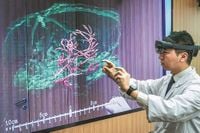China has taken a commanding lead in the global race to develop next-generation computing and neural technologies, making headlines in August 2025 with two remarkable breakthroughs: a record-shattering quantum atom array and significant advances in brain-computer interface (BCI) research. These achievements not only highlight the nation’s scientific prowess but also raise profound questions about the future of human-machine integration, the role of artificial intelligence (AI), and the new centers of technological power.
On August 15, 2025, researchers led by Pan Jianwei at the University of Science and Technology of China unveiled the world’s largest quantum atom array, assembling over 2,000 rubidium atoms without defects in a mere 60 milliseconds. According to Physical Review Letters, this feat marks a tenfold leap in performance compared to previous systems. What sets this experiment apart is the flawless precision and speed, achieved through the use of artificial intelligence. The AI system orchestrates ultra-focused laser beams, known as optical tweezers, to trap and position each atom into perfect patterns—something that previously required painstakingly slow computations and was prone to errors.
“The achievement has been possible thanks to an artificial intelligence system capable of rearranging atoms into perfect patterns through a constant protocol, meaning it doesn’t slow down even when arrays are scaled to thousands of elements,” reported China Daily. This level of control is critical in quantum computing, where even the slightest imperfection can undermine an operation. The new approach not only boosts efficiency but also sets a new standard for the construction of scalable quantum units, potentially opening the door to quantum processors with thousands of stable, controllable elements.
Quantum computing based on neutral atoms is one of the three main branches of the technology, alongside trapped ions and superconducting circuits. Neutral atoms offer a key advantage: they can be stabilized and manipulated in much larger quantities, making them ideal for scaling up quantum processors. China’s previous milestone, the Zuchongzhi 3.0 processor with 105 superconducting qubits, had already demonstrated the country’s growing strength in this arena. The latest atom-based breakthrough complements this by paving the way for hybrid quantum architectures—systems that combine the best of different quantum technologies.
The significance of this achievement is underscored by the fact that, until now, the most advanced systems outside China, such as those at the Max Planck Institute in Germany and US startup Atom Computing, managed to organize only a few hundred atoms. None have matched the scale, speed, or structural cleanliness of the Chinese system. Quantum physicist Jaewook Ahn from the Korea Advanced Institute of Science and Technology observed, “Systems of between 1,000 and 10,000 atoms could begin to function as true quantum processing units.” In other words, the field is now poised to move from laboratory experiments to practical, large-scale quantum systems.
But the story does not end with quantum computing. China is also forging ahead in brain-computer interface research, blending neuroscience, materials science, and robotics with AI to push the boundaries of what’s possible in human-machine symbiosis. As of August 2025, Chinese scientists are making strides in developing BCIs with enormous potential for neurorehabilitation, while grappling with significant surgical and ethical challenges. High-quality brain signal acquisition requires deep brain access, which carries the risk of surgical damage. The quest, as noted by experts in China Daily, is to minimize this damage, primarily by reducing the size of the implantation window.
Cui Yue, an associate researcher at the Institute of Automation at the Chinese Academy of Sciences (CAS), has been at the forefront of this effort. Traditional rigid electrodes, she explains, cannot accommodate the subtle movements of brain tissue and can cause nerve drag and damage. Her team’s solution? Flexible electrodes made from soft, adaptive materials that move naturally with the brain, reducing damage and scarring. “Flexible electrodes, which are made of soft, adaptive materials, can move naturally with brain tissue, reducing damage and scarring, making them more suitable for long-term stable implantation,” Cui told China Daily. The team has managed to reduce implantation damage to just 300 microns and replaced rigid electrodes with these flexible alternatives.
However, the very softness that makes flexible electrodes attractive also makes them difficult to implant. To overcome this, the Institute of Automation developed the “CyberSense” flexible micro-electrode implantation robot, which uses a “sewing machine-style” automatic implantation technology. “Just like threading a needle, we thread the flexible electrode wire into a fine needle and use the needle tip to precisely deliver the electrode to the designated brain area, then withdraw the needle, leaving only the electrode in place,” Cui explained.
The efficiency of reading brain signals is another critical factor, directly impacting the accuracy and complexity of BCI tools. Doctoral student Cao, also quoted by China Daily, noted that many variables influence reading efficiency, including electrode materials and the number of signal collection channels. Increasing the number of channels within the same device volume allows for a more complete capture of brain activity, laying the groundwork for more sophisticated applications. “Breakthroughs in artificial intelligence technology have contributed greatly to the current development of BCIs,” Cao said. “Even when dealing with the same segment of brain signals, AI now enables us to decode richer neural information than before.”
While BCIs currently serve primarily clinical purposes, such as neurorehabilitation, their future applications could include sleep regulation, emotional monitoring, and attention enhancement. As Cao put it, “The current development stage of BCIs is still in its infancy, like a child just learning to walk, but it holds tremendous potential for breakthrough development in the future.”
Both the quantum computing and BCI breakthroughs are propelled by artificial intelligence, creating a feedback loop of innovation. Pan Jianwei’s AI system doesn’t just solve equations—it assembles quantum computers, which in turn could tackle problems that would stump even the most advanced conventional AI. This “double spiral of innovation,” as described by international observers, means that the construction of intelligence may soon become exponential rather than linear.
These advances also signal a shift in the global landscape of scientific leadership. Rather than relying on patents or proprietary hardware, Chinese teams are focusing on invisible assembly, atomic-scale precision, and fine control. In this new era, power is measured not by the number of qubits or patents, but by the ability to put every atom—and perhaps every neural connection—in its exact place.
With these developments, China is not simply catching up to the West; it is setting new standards for what’s possible in both quantum computing and brain-computer interfaces. As the world watches, the boundaries between artificial and human intelligence continue to blur, and the next chapter of technological innovation is being written in real time.





